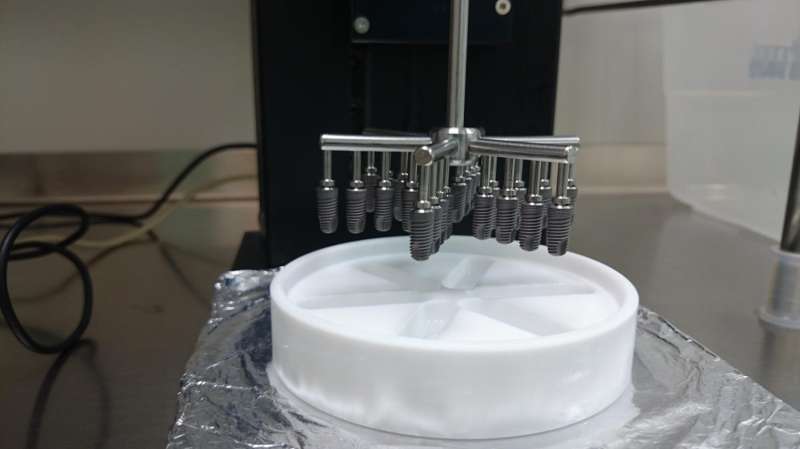Dental implants with antibacterial activity

The quest for surfaces capable of preventing bacterial colonisation and adhesion around dental implants is a subject of research interest, according to Beatriz Palla, a researcher in the Biomaterials Group of the UPV/EHU's Department of Polymer Science and Technology. About 10 percent of implants have to be removed due to osseointegration problems or to the onset of infections.
Design challenges include providing the surface of titanium implants with antibacterial properties while considering the resistance that bacterial strains are capable of developing to conventional therapies with antibiotics. That was the challenge that the UPV/EHU group was keen to tackle. "We had already obtained coatings that facilitate the generation of bone around the implant and thus facilitate anchoring to the bone. To go a step further, we looked at how to turn these coatings into bactericides," said the researcher.
The method they used was sol-gel synthesis. Sol-gel synthesis is based on the preparation of a precursor solution (sol) that, when left on its own for a while, turns into a gel that can be used to coat the surface of the titanium screw, and after heat treatment at a high temperature in the kiln, becomes adhered to the screw that will be implanted. "We used silica as the precursor, because in many studies, this compound has been shown to be osteoinductive, thus facilitating one of the objectives we sought. Additionally, to provide the materials with antibacterial characteristics, we added various antibacterial agents."
In the study, Palla developed three types of coatings depending on the various antibacterial agents chosen; each one had a mechanism to tackle bacterial infections, either prophylactically by preventing the bacteria from initially becoming adhered; by addressing the subsequent infection; or else by eliminating it once developed.
What was needed in the case of prophylactic coatings was "a material with a very long degradation time so that it would remain adhered to the screw and work for as long as possible, preventing bacteria from becoming adhered," said Palla. In the coatings designed to eradicate an infection that has already taken hold, however, "a rapidly degrading material is needed so that it can release the antibacterial agent as quickly as possible to attack the infection." Furthermore, one of the coatings developed for this purpose "is designed to be used in situ, during the surgery itself, on the infected screw, without any need to extract the implant from the patient. This new material is in the process of being patented and remains a trade secret," said the researcher.
In view of the results, Palla believes that "it is possible to confirm that coatings with an antibacterial capability and which do not affect the proper integration of the implant into the jawbone have been developed." She also admits, however, that there is still a long way to go before they can be applied and used during dental surgery: "Apart from all the trials that remain to be carried out, it would also be advisable to pursue the research a little further to optimize the results more."
More information: F. Romero-Gavilán et al, Control of the degradation of silica sol-gel hybrid coatings for metal implants prepared by the triple combination of alkoxysilanes, Journal of Non-Crystalline Solids (2016). DOI: 10.1016/j.jnoncrysol.2016.09.026
Provided by University of the Basque Country



















